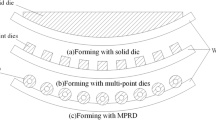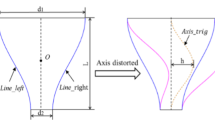Abstract
In this paper, the method of limit analysis is adopted, and three kinds of self-bending extrusion dies controlled by combined function are presented. They are the sin-atan self-bending extrusion die, the sin-erf self-bending extrusion die, and the sin-tanh self-bending extrusion die. Through numerical simulation, self-bending profiles can be obtained from all three kinds of dies. These dies can make the billet flow closer to the real billet flow path and maximize the billet utilization rate. They also can reduce the extrusion load and reduce the local damage of the die and then prolong the die life. It is very effective to predict the bending deformation of the billet by analyzing the central flow line of the billet. It provides a theoretical reference for the design of the actual streamlined self-bending die.














Similar content being viewed by others
Data availability
All data generated or analyzed during this study are included in this article.
References
Yang H, Li H, Zhang ZY, Zhan M, Liu J, Li GJ (2012) Advances and trends on tube bending forming technologies. Chin J Aeronaut 01:1–12. https://doi.org/10.1016/S1000-9361(11)60356-7
Quan JH (2009) Thin-walled tube with small radius and internal medium pressure forming technique. China Metalforming Equipment & Manufacturing Technology 03:103–105. https://doi.org/10.16316/j.issn.1672-0121.2009.03.022
Gao T, Liu YL, Yang H, Wang P (2004) State of the art and trend of backward simulation in metal forming process. J Mech Sci Technol 10:1219–1222. https://doi.org/10.3321/j.issn:1003-8728.2004.10.026
Ayer Ö (2019) A forming load analysis for extrusion process of AZ31 magnesium. Trans Nonferrous Met Soc China 4:741–753. https://doi.org/10.1016/S1003-6326(19)64984-8
Wu XH, Zhao GQ, Sun S, Ma XW (2006) Porthole die extrusion process numerical simulation and die stress analysis. China Mech Eng S1:106–109 JournalArticle/5aed8a29c095d710d40d2533
Teimouri R, Baseri H (2015) Forward and backward predictions of the friction stir welding parameters using fuzzy-artificial bee colony-imperialist competitive algorithm systems. J Intell Manuf 26:307–319. https://doi.org/10.1007/s10845-013-0784-4
Xiao H (2010) Research on bending processes of lightweight structures. Dissertation, Dalian University of Technology
Xu Y (2008) Application of numerical simulation in the bending of magnesium alloy extruded profiles. Dissertation, Hunan University
Jin M, Zhou XB, Li XX, Bai D (2003) Stretching bending for aluminium profile with large dimension section. J Plast Eng 06:46–49. https://doi.org/10.3969/j.issn.1007-2012.2003.06.012
Xu Y, Li LX, Li GY, Zhong ZH (2008) Extrusion bending: method, application and recent development. J Plast Eng 03:61–70 CNKI:SUN:SXGC.0.2008–03-013
Chen XX, Zhao GQ, Liu GL, Sun L, Chen L, Zhang CS (2020) Microstructure evolution and mechanical properties of 2196 Al-Li alloy in hot extrusion process. J Mater Process Technol 275:116348. https://doi.org/10.1016/j.jmatprotec.2019.116348
Li CM, Wang Xiang L, Yan HJ (2006) DEFORM5.03 metal forming finite element analysis example tutorial. Machinery industry press, Beijing
Den Bakker AJ, Werkhoven RJ, Sillekens WH, Katgerman L (2014) The origin of weld seam defects related to metal flow in the hot extrusion of aluminium alloys EN AW-6060 and EN AW-6082. J Mater Process Technol 11:2349–2358. https://doi.org/10.1016/j.jmatprotec.2014.05.001
Wang TP, Qi KM (2012) Metal plastic processing technology-rolling theory and technology. Metallurgical Engineering, Beijing
Xu ZT, Peng LF, Bao EZ (2017) Size effect affected springback in micro/meso scale bending process: experiments and numerical modeling. J Mater Process Technol 252:407–420. https://doi.org/10.1016/j.jmatprotec.2017.08.040
Chen ZZ, Lou ZL, Ruan XY, Bao ZX (2005) Finite volume simulation of extrusion of complex aluminum profile. J Shanghai Jiao Tong Univ 01:27–31+40. https://doi.org/10.3321/j.issn:1006-2467.2005.01.007
Wang C, Yu GC, Wang W, Zhao J (2018) Deflection detection and curve fitting in three-roll continuous straightening process for LSAW pipes. J Mater Process Technol 255:150–160. https://doi.org/10.1016/j.jmatprotec.2017.11.060
Chen H, Zhao GQ, Zhang CS, Guan YM (2011) Numerical simulation of extrusion process and die structure optimization for a hollow aluminum profile with thin wall. J Mech Eng 24:34–39. https://doi.org/10.3901/JME.2010.24.034
Vollertsen F, Sprenger KJ, Horst AM (1999) Extrusion, channel, and profile bending: a review. J Mater Process Technol 1:1–27. https://doi.org/10.1016/S0924-0136(98)00339-2
Shiraishi M, Nikawa M, Goto Y (2003) An investigation of the curvature of bars and tubes extruded through inclined dies. Int J Mach Tool Manu 15:1571–1578. https://doi.org/10.1016/S0890-6955(03)00201-3
Müller KB (2006) Bending of extruded profiles during extrusion process. Int J Mach Tool Manu 11:1238–1242. https://doi.org/10.1016/j.ijmachtools.2006.01.036
Chen L, Zhao GQ, Yu JQ (2015) Effects of ram velocity on pyramid die extrusion of hollow aluminum profile. Int J Adv Manuf Technol 79:2117–2125. https://doi.org/10.1007/s00170-015-7059-5
Ren J (2016) Research on forming force of radial expansion – closed control extrusion. Dissertation, North University of China
Yu HQ, Chen JD (1999) Principles of metal plastic forming. Machinery Industry Press, Beijing
Gordon WA, Van Tyne CJ, Moon YH (2007) Axisymmetric extrusion through adaptable dies - part 2: comparison of velocity fields. Int J Mech Sci 1:96–103. https://doi.org/10.1016/j.ijmecsci.2006.07.012
Gordon WA, Van Tyne CJ, Moon YH (2006) Axisymmetric extrusion through adaptable dies—part 3: minimum pressure streamlined die shapes. Int J Mech Sci 1:104–115. https://doi.org/10.1016/j.ijmecsci.2006.07.013
Rejaeian M, Aghaie-Khafri M (2015) A new approach for modeling of streamlined die operations based on a non-quadratic stream function. Int J Mech Sci 101-102:376–386. https://doi.org/10.1016/j.ijmecsci.2015.08.011
Shi L (2015) Investigation on deformation mechanism of aluminum alloy during porthole ECAP spread extrusion. Dissertation, Northwestern Polytechnical University
Zhou ZY, Pan JY, Wang Y, Tan ZD, Chen HA (2009) Numerical simulation of metallic flow forming via extrusion in pocket and porthole dies. J South China Univ Technol (Natural Science Edition) 11:145–150. https://doi.org/10.3321/j.issn:1000-565X.2009.11.026
Yu BY, Yan L, Song HW, Zheng L, Wang YX (2007) Numerical analysis and optimal design of porthole compound dies. J Plast Eng 05:79–82. https://doi.org/10.3969/j.issn.1007-2012.2007.05.018
Bai SW, Fang G, Zhou J (2019) Integrated physical and numerical simulations of weld seam formation during extrusion of magnesium alloy. J Mater Process Technol 266:82–95. https://doi.org/10.1016/j.jmatprotec.2018.10.025
Funding
This work was supported by the Natural Science Foundation of Shandong Province (Project Number ZR2017MEE036) and Zibo City School City Integration Development Project (Project Number 2017ZBXC205).
Author information
Authors and Affiliations
Contributions
Fanlei Min and Huiping Liu contributed equally.
Fanlei Min: Conceptualization; Methodology; Software; Writing, Original Draft
Huiping Liu: Software; Validation; Writing, Original Draft; Writing - Review and Editing
Guangming Zhu: Resources; Supervision
Zheng Chang: Resources; Supervision
Nana Guo: Investigation
Jianbo Song: Investigation
Corresponding author
Ethics declarations
Ethical approval
This chapter does not contain any studies with human participants or animals performed by any of the authors.
Consent to participate
Not applicable.
Consent to publish
All authors have read and agreed to the published version of the manuscript.
Competing interests
The authors declare no competing interests.
Code availability
The code is available.
Additional information
Publisher’s note
Springer Nature remains neutral with regard to jurisdictional claims in published maps and institutional affiliations.
Rights and permissions
About this article
Cite this article
Min, F., Liu, H., Zhu, G. et al. The streamlined design of self-bending extrusion die. Int J Adv Manuf Technol 116, 363–373 (2021). https://doi.org/10.1007/s00170-021-06760-w
Received:
Accepted:
Published:
Issue Date:
DOI: https://doi.org/10.1007/s00170-021-06760-w




